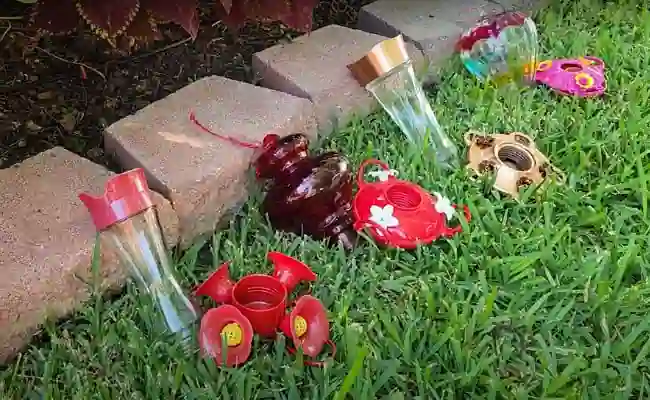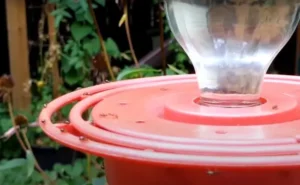A hummingbird feeder is a colorful snack device put outside the home to supply food to tiny, fast-flying birds. What makes it special is the sweet drink inside – a favorite juice for them!
The functionality and proper maintenance of these feeders not only ensures the health and safety of hummingbirds but also enhances the birdwatching experience for enthusiasts.
They are designed to give a copy of nectar-producing flowers, offering a reliable food source and attracting them to homes and gardens.
Their importance extends beyond mere attraction; they play a key role in the survival of hummingbirds during migration and in areas where natural food sources are limited.
Table of Contents
Understanding Hummingbirds
Before understanding the mechanics of hummingbird feeders, a brief overview of these birds is essential. Known for their vibrant plumage and rapid wing beats, hummingbirds primarily feed on nectar, supplemented by insects and spider webs for protein. Their high metabolism necessitates frequent feeding, making feeders an invaluable resource.
“Hummers need nectar to power the bug-eating machine that they are.”
Hummingbirds love to drink from the flowers, but when they see a huge reservoir of nectar, they are all attracted to it. These are of different shapes and sizes and also have different types including saucer or dish-style feeders, bottle or tube-style feeders, and decorative feeders as well.
Interesting History of Hummingbird Feeders
In 1920, Margaret L. Bodin experimented with feeding hummingbirds. He used two-inch-long colorful bottles filled with sugar water that she put them among clematis flowers. Seeing this, Edith Webster, the wife of Laurence J. Webster from Boston experimented with the same and her husband made clear glass cylindrical feeders with two parts water to one water sugar. There were two red-colored glass feeding parts at the base.
Edith Webster became an associate in the American Ornithologists’ Union in 1936 which was letred named as the American Ornithological Society in 1916. H. R. Davis, Robert Morgan, Winthrop Packard, and the Tucker Sanctuary had built feeders and sold them from 1930 to 1950. With commercialization, two designs of hummingbird feeders vacuum and saucer were sold largely.
The first hummingbird feeder in history was built by a man named Laurence J. Webster from Boston. He built that feeder for his wife. His wife had read a National Geographic story in 1928 about feeding hummingbirds using small glass bottles.
She was also elected as an associate of the American Ornithologists’ Union in 1936. That union then merged with Cooper Ornithological Society in 2016 and named it the American Ornithological Society.
Sometime between the years 1929 and 1935, Webster designed a blown-glass hummingbird feeder for his wife. In 1947, there was an article in National Geographic by Harold Edgerton about a new kind of strobe flash he invented. The article included pictures of hummingbirds at Webster’s feeder. People got interested, and in 1950, the Audubon Novelty Company Medina, NY started selling the Webster feeder.
Types of Hummingbird feeders?
There are 2 main types of hummingbird feeders, vacuum feeders and other is saucer type feeders. The hummingbird feeder is only going to be as good as the parts it is made with.
Vacuum / Bottle Feeders
The vacuum feeders are also called inverted bottle feeders. This type of feeder has a bottle-shaped reservoir to contain the nectar in it, and it has a base that is connected to the reservoir with a seal.
The base is the bottom part of the feeder that holds the jar in place and provides stability. There is physics behind the working of a vacuum feeder, and I will discuss that in the last section of this guide. See the advantages of a vacuum hummingbird feeder:
- Bottle feeders can hold a large amount of nectar.
- It is less likely to be tipped over by birds.
- It can be hung or mounted in a variety of ways.
- It can be difficult to keep clean, especially if mold or mildew grows inside the bottle that holds nectar.
- Nectar can become cloudy or fermented if not changed regularly
- Can attract bees and other insects
Saucer feeders/ Dish style feeders
Saucer feeders have an upside-down reservoir. This feeder can also be called a dish-styled feeder as it resembles the dish. Saucer feeders are less messy, less likely to leak, and easier to clean than bottle feeders.
They also typically hold less nectar but they are amazing as they do not often leak. I prefer saucer feeders over bottle feeders because of their simplicity, ease of cleaning, and effectiveness in attracting hummingbirds. The advantages of this feeder are:
- They are easy to clean and refill.
- The nectar is less likely to leak in the saucer feeder.
- Attracts fewer bees and other insects.
- Nectar stays fresh longer.
- It can hold less nectar than bottle feeders.
- It can be tipped over by birds.
The Physics Behind Hummingbird Feeders
The Hummingbird feeder functionality is based on the principles of pressure and air displacement. It is to prevent the liquid from overflowing from the ports or openings that are used by hummingbirds to get nectar.
Hummingbird feeder has two chambers, one is the reservoir itself and the other is the base. The base can also be said to be the feeding chamber. The liquid level in the inner reservoir is higher than in the feeding chamber, creating a pressure difference that prevents overflow of the nectar.
When the nectar in the feeding chamber is consumed by the hummingbirds then air enters the bottle through the feeding holes, which equalizes the pressure and allows more liquid to flow into the feeding chamber from the reservoir. This process creates a feedback loop that regulates the liquid level.
The force on the bottom piece of the feeder depends on the height of the liquid column, as it exerts a downward force from the stored nectar. The design of the feeder ensures that the force the liquid exerts on the bottom piece is independent of the liquid column’s height, preventing overflow and maintaining a stable equilibrium.
So, this is how does a bottle hummingbird feeder works. The physics behind hummingbird feeders involves a delicate balance of forces and pressures, which allows for the controlled flow of liquid to the feeding chamber without overflowing.
How does a hummingbird feeder work?
A hummingbird feeder consists of several parts that work together to provide nectar for these small, colorful birds.
Components of a Typical Hummingbird Feeder & their Functions:
1. Nectar reservoir
- A tightly sealed nectar reservoir is made of glass or plastic and stores the sugary liquid that hummers feed on.
- It is in detachable bottle or integrated reservoir designs that allow filling, and cleaning.
- When Its leaked-proof lid is screwed into the base in the upright position, gravity draws nectar down from the inverted reservoir into the base.
- It holds between 8 – 64 oz, depending on feeder capacity.
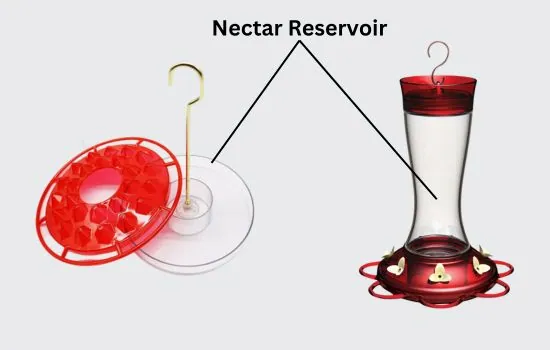
2. Base
- It is the bottom of the feeder that houses the reservoir and attachments. It connects the reservoir to the feeding ports and forms the foundation.
- Made of materials like plastic, glass, or pottery, it forms the bottom structure of the feeder and won’t degrade with nectar and water exposure over time.
3. Feeding ports / Feeding port openings
- These are little flowers or covers that surround the feeding ports.
- There are typically 2 to 12 small plastic or metal feeding ports arranged in a circular fashion on the base of the feeder surrounding the central reservoir. This provides multiple access points for hummingbirds.
- The feeding port itself is a small hole, usually about a 1/8 inch wide, made of plastic or metal tubing that protrudes slightly from the base. This is sized for a hummer’s beak.
- The opening has a colorful plastic or fabric flower cover with petals that surround it. Their bright colors and flowers around the ports grab hummers to feed.
- The cover has openings between the petals, which allows birds to insert their beaks completely into the port openings underneath.
- The port openings provide a direct path into the nectar reservoir so birds can access the sugary liquid.
- Ports restrict larger insects.
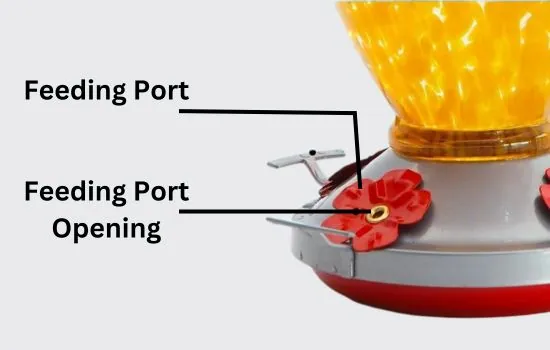
5. Basin/moat
- It is the outer dish/reservoir that surrounds the feeding ports and holds water.
- It mimics natural pools or moisture that attracts hummingbirds to rest and bathe.
- It provides a landing spot so they can comfortably enjoy the nectar. The circular basin surrounding the ports holds water and provides landing spots.
6. Hanger/hook
- Hanger is found at the top of the feeder so it can be hung from a tree/porch. It is often an integrated ring or hook.
- The hanging makes the feeder visually apparent as it moves in the breeze, which attracts birds.
- It also raises to an optimal feeding height.
- The swinging and spinning feeder is eye-catching which draws in more hummingbirds.
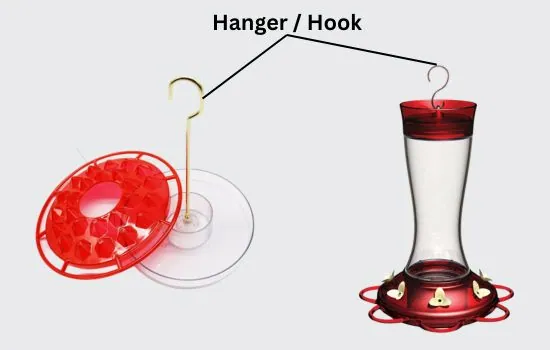
7. Bee guards
- The small grate/grille structures are fitted over feeding ports to deter bigger insects.
- Many feeders have built-in bee guards that are essentially plastic barriers around the feeding ports to allow a hummingbird’s long, slender beak to reach the nectar, but block the shorter beak of a bee.
- These act as a physical impediment to bees.
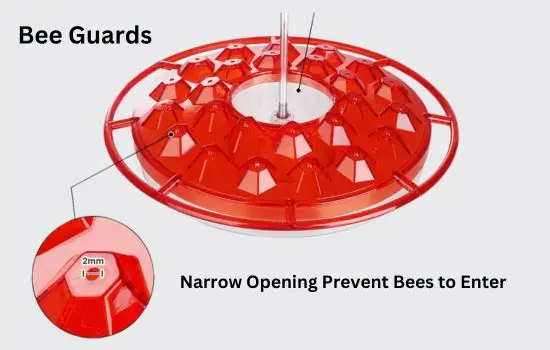
8. Nectar flow regulator or tubes
- These small inner tubes control/slow the liquid nectar flow.
- They regulate nectar volume flowing down to the ports for consumption.
- They prevent flooding of nectar so hummingbirds don’t choke.
- Built-in tubing forms a channel from the reservoir to the ports to convey nectar.
- The tubes have narrow openings to control and slow down flow through capillary action so ports don’t flood.
9. Perches
- Hummingbird feeder perches are textured surfaces positioned near the nectar ports that provide a place for the birds to comfortably rest their feet while feeding.
- They reduce the energy hummingbirds expend to access nectar by allowing them to periodically stop their hover at the feeder and sit.
- This careful placement of perches – high enough to avoid contamination but lower than the feeding ports for easy accessibility – maximizes both cleanliness and usage.
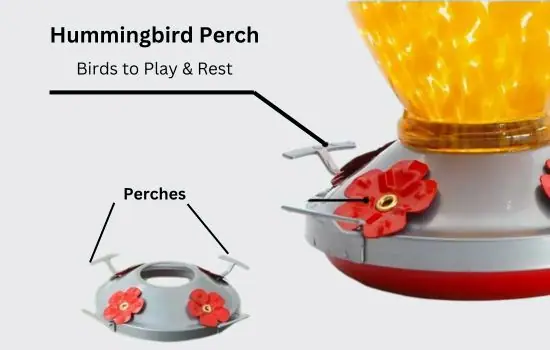
10. Liquid level indicator
- It is a clear visual gauge showing how much nectar is left in some models.
11. Instruction label
- It details proper use, cleaning tips, nectar recipes, etc.
12. Ant moat
- It is a small water-filled moat around the hanger designed to prevent ants from reaching the feeder.
- They are not as common as the basin/nectar moat.
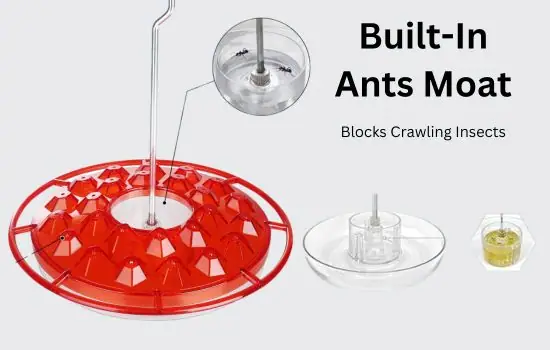
13. Nesting base
- Some feeders have a detachable plastic base meant for hummingbirds to build nests on.
- It allows you to observe baby birds.
14. Insulation
- A few select models have double-walled reservoirs with an insulation barrier to help keep nectar cool.
- It prevents spoilage.
15. Fill tube/funnel
- Aftermarket plastic nectar filling tubes or funnels that attach to feeding port to aid filling.
- They are easier than pouring into the reservoir.
This covers how the key structural components interconnect and the mechanics of how nectar flows allowing hummingbirds access to the sugary nourishment. Let me know if you need any clarification or have additional questions!
Conclusion
Hummingbird feeders are crucial to attracting hummingbirds, and it is also essential to know how do hummingbird feeders work. They offer an alternate energy source other than flowers.
The functionality of hummingbird feeders involves key components like the reservoir, feeding ports, base, lid, perches, ant moats, and bee guards.
Hopefully, by reading this article, you have gained insights into how does a hummingbird feeder works and what is the role of physics in it. Understanding their components and how they function is critical to creating a welcoming environment for these vibrant birds. If you want to attract hundreds of hummingbirds to your yard, then you must read our guide to attract hummingbirds.

